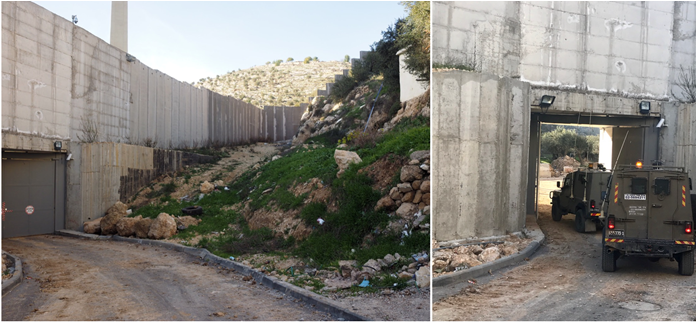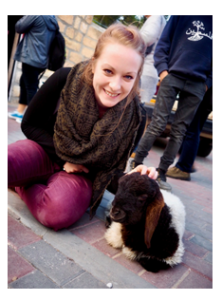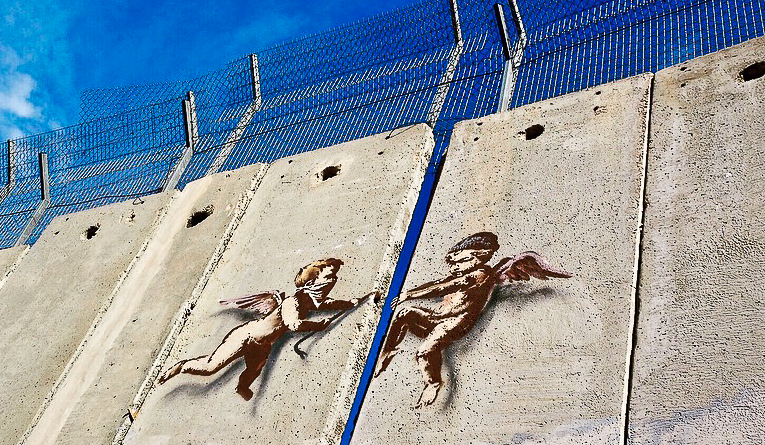An Invitation to Witness – by Claire Dixon
Photo above: The latest painting by UK-based grafitti artist Banksy on the Separation Wall in Bethlehem depicts two angels trying to pry open the wall at the location of a slight gap. The angels appeared for the Christmas 2017 season, suddenly and anonymously, as with other Banksy art around the world. Photo: Claire Dixon
“So how, if empathy requires perspective-taking, how do we take the perspective of other people, if the lens that we see the world through is soldered to us? The answer is, you believe people’s stories. You believe people’s experiences as they tell them to you.” -Brene Brown
Just a few short weeks ago I was in the West Bank planting olive trees with Palestinian farmers on their threatened land. The accompaniment work was organized through a joint program of the YMCA/YWCA of Palestine. It feels like a lifetime and a world away now, as I am back in my comfortable home and life in Chicago. But I am still thinking of and attempting to process what I saw and heard while in Israel/Palestine.
In Chicago I work as a Social Worker, providing support services to foreign-born survivors of human trafficking. I also enjoy photography, which carries helpful metaphors for travel and working with people who hold different stories than my own. For we each bear our own lens through which we see the world, and it can be difficult to shift from these lenses. Varying, and even contradicting lenses contribute to injustice committed against one another.
I believe that an element of peacemaking and justice work involves effort to open yourself up to another’s perspective and attempt to see through the “other’s” lens. Going even further, I believe it can even be more powerful when you allow another person to take a photo through your camera, and they teach you from their lens how they view the world. My clients are immigrants that live in the United States who were either brought here under the false pretenses of employment, or who already lived here and then were forced into exploitative labor. The more time I spend with them and hear their stories of immense trauma, and their struggles in the “Land of the Free,” the more I am exposed to the underbelly of exploitative labor and capitalism in my own country, city and even neighborhood. As I sit with my clients and believe the weight of their words and experiences, my worldview lens is challenged and transformed.
While in Palestine, I thought of my clients and my work back in the US often. It is natural when one travels to new spaces to try to make connections and parallels to your own space in order to help garner understanding. I observed parallels between the relationship of Palestine and Israel to the relationship of my clients and their abusers, the Oppressed and the Oppressor. The “Power and Control Wheel” is a device that is often used to help people understand domestic violence. In the center of the relationship between the Oppressor and the Oppressed is power and control, and the interconnected spokes of the wheel are tools that allow the Oppressor to maintain control of the Oppressed person. Yes, there is physical abuse that often happens. And yes, sometimes the person being abused is literally chained to one place and cannot leave. But these are not the only instances of abuse. Perhaps more formidable than acts of physical violence are the insidious tools of abuse happening underneath the surface that create a larger system and pattern of abuse needed for one to have power and control over another. These tools include: economic abuse, emotional abuse, coercion and threats, intimidation, isolation, and blaming the oppressed and denying abusive actions.

I saw a myriad of examples of these insidious tools of abuse abetting control and power while I was in Israel/Palestine. These included: the identification permit system which creates a hierarchy of rights and restricts movement of people; laws and policies that are discriminatory against Palestinians; the forced isolation of Gaza; the constant presence of heavily-armed Israeli military; continuous threats and actual demolition of Palestinian homes and the seizing of land; propaganda from the Israeli government that positions Israelis against Palestinians; the denials of injustice espoused by Israel to the outside world; and the list goes on. Furthermore, I found the seemingly arbitrariness of policies and actions of the Israeli government and military as hugely significant.
Continuing in the framework of abusive power, the uncertainty and fear of what will come is an aspect of control. Those in power are able to dole out decisions and policies and arrests and the placement of walls arbitrarily, but also deliberately, to maintain control over Palestinians. While in the town of Beit Jala in the West Bank, our group met a Palestinian woman, Nadeen, whose land was recently cut off by the construction of the separation Wall just meters from her home. She told us she had received a notice 12 years ago from the Israeli government instructing her not to wall off her land, because they would be constructing part of the Wall nearby. For 12 years, Nadeen had this direct threat hanging over her head, and knew that one day she might be separated from her fields.
Within domestic violence and human trafficking, the oppressor keeps the oppressed on a figurative string; the abused does not know what the abuser will do next, and little by little things are taken from them, resulting in fewer and fewer resources with which to fight back. And often, the abuse is happening underneath the surface, all the while the oppressor showcases their positive power and might to the external world. In the case of Israel and Palestine, we cannot rely on the oppressor to share with us what is happening beneath the surface. It is our responsibility to be conscious global citizens who are seeking to see beneath the gleaming surface of nationalism and religious zeal. But first this means we must listen to the stories and experiences of others, and seek to see from their lenses.
“I don’t see peace,” Nadeen shared with us, as we stood by the separation Wall that arbitrarily cuts her off from her family’s land and ancient olive trees. “I don’t know what they will do. How am I supposed to know how they think. We don’t know.” She goes on to explain that in order to access her fields, to harvest her olives and care for her bees, she and her son have to go way out of their way around a section of the Wall to enter through a military checkpoint. There they are scrutinized by the Israeli military who choose whether or not to allow them passage to work in their fields. Fields that have been in their family for hundreds of years; land they legally own. She looks to be around 65 years old, very much deserving of rest and retirement at this point in her life. She explains that she goes with her son each time to stand near him while he checks on their bees, because she is scared that something will happen to him when he is in his bee suit and has his back turned. Someone in my group asks her if she needs help, if having internationals help her harvest would offer some protection for her family. “No no,” she says. “ I like to pick my own olives and harvest my land. It is remembrance for me.”
In the brief moments we shared by the Wall, Nadeen graciously offered my group a glimpse into her experience of living in the shadow of decades of oppression and injustice. Her hospitality so freely given, was an invitation to accept and believe her story, and then to allow her story to transform our lenses.
Believing other people’s stories, as Brene Brown has said, is “perspective-taking” and is a step toward empathy. But, as her research on human connections shows, we must also seek to understand the cycle of abuse and trauma, understanding that often, those who oppress were once the oppressed. I do not write this to dehumanize Israelis. Instead, this is as an invitation to delve into the messiness and complexity that is the human story. And to stand witness with the marginalized, whoever they may be, uplifting their stories against the power of the oppressor, and plugging them into the power of the interconnected world.
Claire Dixon is a social worker and amateur photographer who lives and works in Chicago. She has

her Master’s in Clinical Social Work, and dreams of traveling the world, combining her love of photography with social justice work. This article was written after her February 2018 olive-tree-planting trip with Keep Hope Alive, a Joint Advocacy Initiative of the East Jerusalem YMCA/YWCA of Palestine.

